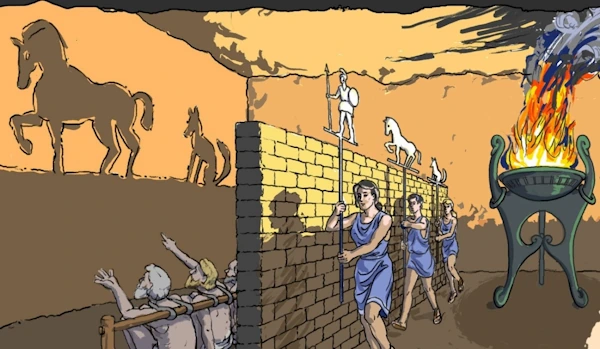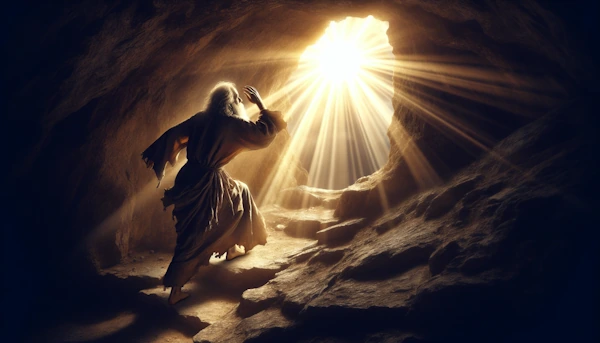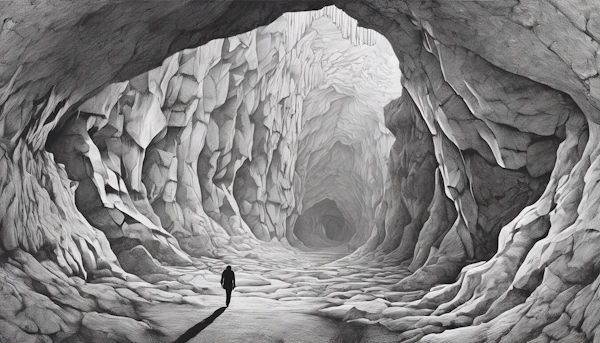
Introduction: Perceptions Shape Reality
Plunging into the allegorical depths where shadows and light clash, the myth of the cave meaning emerges as a cornerstone of philosophical thought, urging a reevaluation of perception, knowledge, and freedom. Crafted by the ancient philosopher Plato through Socrates’ dialogue, this allegory invites an exploration into the juxtaposition of illusion versus reality, chaining the prisoners in a world of shadows, believed to reflect the ultimate truth. Such profound exploration transcends merely the notion of imprisonment within a cave; it symbolizes the human condition ensnared in the deceptive appearances of the material world, advocating for a painstaking journey towards liberation and enlightenment through the power of questioning, skepticism, and the relentless pursuit of wisdom.
This article unfolds the layers of the myth of the cave meaning, navigating through its relevance in modern times where technology, akin to the Platonic cave, casts new shadows on the walls of perception. It will delve into how the allegory’s themes of freedom, illusion, and the quest for truth find resonance in the age of smartphones and social media, shedding light on the contemporary chains that bind the human senses and intellect. Furthermore, it shall explore the individual’s arduous path from ignorance to philosophical knowledge, highlighting the enlightenment’s dual edge of liberation and isolation. Through this philosophical journey, readers will gain insight into the enduring legacy of Plato’s allegory, unpacking its significance in understanding the boundless quest for truth amid a world awash with illusions.
Understanding the Allegory of the Cave
Plato’s Allegory of the Cave, narrated by Socrates in a dialogue with Glaucon, presents a profound metaphor for the human condition regarding knowledge, reality, and ignorance. In this myth, some prisoners find themselves from childhood being chained in a cave, specifically sitting in front of a wall. A fire is burning behind them, and between it and the prisoners are puppeteers who create shadows on the wall thanks to the light produced by the fire. The shadows represent animals and objects. The chained men, knowing nothing else, observe the silhouettes projected on the cave wall, considering them real and true.
For some unknown reason, a prisoner manages to break free from his chains and decides to leave the cave. He therefore climbs upward, and when he finds the entrance to the cave, he is dazzled by the sunlight. The discomfort is so intense that it causes him a moment’s hesitation, but he does not give up and finally emerges from his underground abode. His eyes soon adapt to the light of the real world and he begins to perceive colors he has never seen before; then he sees trees, clouds in the sky, animals, and hears the sounds of nature. Before that moment the man could not even imagine that such beauty existed.
Feeling a mixture of elation and surprise, he decides to descend back into the dark cave to inform his companions of his incredible discovery. At this point the unthinkable happens. They do not believe him; in fact, they begin to mock him, thinking he is crazy. The situation quickly escalates from teasing to violence: the prisoners beat the freed man to death.
- The Cave as Reality: The prisoners in Plato’s cave have lived there since childhood, their reality confined to the shadows cast on the wall. These shadows form their understanding of the world, a stark depiction of how humans accept the information presented to them without questioning its veracity.
- Escape and Enlightenment: The allegory progresses as one captive escapes and is initially overwhelmed by the world outside the cave. This world, bright and filled with real objects, represents enlightenment and truth, starkly different from the deceptive shadows. The freed prisoner’s journey from the cave into the light symbolizes the painful yet essential escape from ignorance to knowledge.
- The Return: The most poignant part of the myth occurs when the freed prisoner returns to the cave. His attempt to enlighten his fellow prisoners is met with hostility and disbelief. They, still in chains, prefer the comfort of their familiar shadows, illustrating the resistance often encountered when introducing new, challenging ideas.
- Philosophical Implications: Plato uses this narrative to discuss the effects of education and the lack of it on human nature. The cave represents people uneducated in the Theory of Forms, who see only the shadows of reality. This allegory not only questions the nature of reality but also challenges the educational systems that do not foster critical thinking and philosophical questioning.
- Modern Reflections: In contemporary society, technology plays the role of the fire casting shadows. Televisions and smartphones produce a barrage of information that, like the shadows on the cave wall, can be a distorted representation of reality. This modern twist to the allegory invites reflection on how media and technology can act as modern chains that limit understanding and perception.

Plato’s allegory remains a crucial narrative for understanding human behavior and the pursuit of knowledge. It encourages the questioning of the information and the world around us, advocating for a deeper understanding of what lies beyond the shadows.
The Cave: A Metaphor for Ignorance
Plato’s Allegory of the Cave serves as an eloquent metaphor for the human condition, emphasizing the stark contrast between the shadows perceived as reality by the prisoners and the true form of reality that exists outside the cave. This allegory not only explores the physical limitations imposed by the chains but also delves into the intellectual darkness that pervades the cavern, symbolizing widespread ignorance.
- The Fire as a Source of Illusion: The fire, which lies behind the chained people, represents the medium through which the puppeteers cast illusory shadows. It could be compared, coming back to our times, to the bright screens of the smartphone and television, which similarly shape people’s perceptions and beliefs without ever really delving into them.
- Escape and Realization: The narrative proceeds with a prisoner’s escape from the dark cavern. Initially, he is overwhelmed by the sunlight, which is infinitely more powerful than the light of the fire he was used to. The escaped prisoner’s realization that the shadows are not reality but mere reflections of actual objects underscores the transformative power of true understanding.
- Resistance to Enlightenment: Upon returning to the cave to share his newfound knowledge, the enlightened prisoner faces hostility and disbelief. This resistance highlights a critical aspect of human nature: the reluctance to challenge long-held beliefs and the comfort of familiar illusions. It reflects the broader societal challenge where truth-seekers must often confront skepticism and opposition.
- Symbols of Ignorance and Knowledge: The chains and shadows within the cave symbolize the constraints of ignorance, while the world outside represents the expansive realm of knowledge and truth. The journey out of the cave is a metaphor for the individual’s quest to overcome ignorance and achieve philosophical enlightenment.
- Modern Day Caves: In today’s context, the cavern can be likened to various forms of media that shape our understanding of the world. Televisions and smartphones, much like the shadows in the cave, provide a perception of reality that is often a distorted simplification of the actual world. This modern twist on the allegory urges us to question and critically evaluate the information we consume daily.
By understanding “The Cave: A Metaphor for Ignorance,” we are reminded of the importance of questioning our perceptions and seeking deeper truths beyond the apparent realities presented to us. Plato’s allegory remains a powerful tool for philosophical inquiry and self-reflection, encouraging us to liberate ourselves from the figurative chains of ignorance and explore the enlightening path of knowledge.
The Shadows: Perceptions vs. Reality
In Plato’s Allegory of the Cave, the shadows cast on the cave wall play a central role in shaping the prisoners’ perception of reality. These shadows, mere reflections of objects manipulated by unseen puppeteers, become the entirety of the prisoners’ world, illustrating a profound philosophical inquiry into the nature of perception versus reality.
- Nature of the Shadows: The captives, bound and unable to turn their heads, perceive the shadows as the only reality they know. Plato, through Socrates, describes this scenario to highlight how sensory perceptions can be deceiving. The shadows are not just images but are interpreted by the prisoners as the actual entities themselves, demonstrating the ease with which humans accept incomplete representations as truth.
- Philosophical Significance of the Shadows: The shadows symbolize the distorted perceptions that often constitute human understanding. These illusions are mistaken for reality due to the prisoners’ limited perspective and lack of exposure to the world outside the cave. This metaphor extends to the modern technological landscape, where media and information, like the shadows, often provide a skewed representation of reality, keeping individuals chained in a state of ignorance.
- Modern Technology as Plato’s Fire: Echoing the special user request, modern technology can be seen as the fire in Plato’s allegory, casting digital shadows through smartphones and televisions. These devices shape perceptions and often distort reality, much like the fire behind the prisoners. This modern parallel serves as a critical reflection on how contemporary society is influenced by the illusions disseminated through digital screens.
- Challenges of Recognizing Reality: The journey to recognize and accept true reality is fraught with challenges. As the freed prisoner returns to the cave to inform the others, his insights are met with hostility. This resistance mirrors the modern reluctance to move beyond familiar but deceptive comforts offered by technology and media. The process of awakening to the truth of our perceptions is often a solitary and strenuous journey, distancing us from those who remain content within the confines of the cave.
- Transcendence from Shadows to Reality: The myth encourages a move from shadowy illusions to the enlightenment of true knowledge. This philosophical journey involves questioning and critically assessing the information that shapes our perceptions. It is a call to break free from the chains of passivity and challenge the shadows that dominate our understanding of the world.
By exploring “The Shadows: Perceptions vs. Reality,” we delve into the core of Platonic philosophy, where understanding the distinction between what appears to be and what truly is becomes essential for intellectual and spiritual freedom. This section underscores the timeless relevance of Plato’s allegory, urging a vigilant examination of the shadows that continue to loom large over human perception in contemporary society.
The Escape: Journey Toward Enlightenment
The narrative of the prisoner’s escape in Plato’s Allegory of the Cave serves as a suggestive metaphor for the transformative journey from ignorance to enlightenment. This section explores the sequential stages of the prisoner’s enlightenment and its implications for personal and philosophical growth.

- Initial Liberation and Disorientation: The escape begins with a captive being freed from physical chains, symbolizing the first step towards intellectual freedom. Initially, the light from the fire is blinding, representing the shock of new, true knowledge that starkly contrasts with the prisoner’s former understanding based on shadows.
- Gradual Adjustment and Realization: As the prisoner’s eyes adjust to the light, he begins to perceive and understand the true forms behind the shadows. This stage symbolizes the challenging yet crucial process of reevaluating one’s beliefs and perceptions in light of new information and realities.
- Venturing Outside the Cave: Driven by curiosity and a burgeoning understanding, the freed prisoner steps outside the cave. Here, he encounters the overwhelming brilliance of the sun and the true beauty of the world. This represents the expansive nature of enlightenment, where one not only learns new truths but also appreciates the vastness and complexity of reality beyond previously held beliefs.
- The Burden of Enlightenment: With enlightenment comes the responsibility of knowledge. The freed captive feels a profound duty to return to the cave and share his newfound understanding with others. This stage reflects the philosophical and ethical dilemmas associated with possessing knowledge that others do not accept or understand.
- Encountering Resistance and Rejection: Upon returning to the cave, the enlightened prisoner faces skepticism and hostility from those still chained. This resistance underlines a critical aspect of human nature: the comfort found in familiar ignorance and the fear of transformative truth.
- Philosophical Implications and Modern Parallels: The journey of the escaped prisoner mirrors the challenges faced by individuals today as they confront and navigate the illusions cast by modern technology. Devices like smartphones and televisions, much like the shadows on the cave wall, often distort reality, keeping individuals chained to a superficial understanding of the world. The evolution of artificial intelligence is further complicating things, since it can produce completely realistic images and videos, inducing false perceptions and beliefs in people.
This exploration of the journey toward enlightenment not only deepens our understanding of Plato’s allegory but also invites us to reflect on our own experiences of discovering and accepting truths about ourselves and the world around us. It challenges us to consider how we, too, can move beyond the shadows of our contemporary caves.
The Return: Resistance to New Knowledge
When the enlightened prisoner returns to the cave, his attempts to share his newfound insights are met with resistance and hostility. This reaction underscores a profound philosophical and societal challenge: the resistance to new knowledge, which is often steeped in the comfort of familiar illusions.
- Burden of the Enlightened: The individual who has escaped the cave faces the daunting task of reintegrating into the cavern environment to share the enlightenment. This is not just a physical return but a moral and intellectual challenge. The enlightened one bears the burden of knowledge and the responsibility to disseminate it, despite knowing the likely resistance.
- Hostility Towards Change: Those still in the cave react with suspicion and aggression towards the returned prisoner. This hostility can be understood as a defense mechanism against the destabilizing effects of new ideas that challenge their perceived reality. It reflects a broader societal tendency where new, transformative ideas are often met with resistance or outright rejection.
- Comfort in Illusion: The prisoners’ preference for the shadowy illusions over the harsh realities of the light illustrates the human tendency to choose comfort over truth. This aspect of the allegory resonates with the modern technological illusions provided by media and smartphones, which often offer a simplified and more palatable version of reality.
- Philosophical Education and Transformation: Plato emphasizes that true education is a transformational process that involves a complete turn-around of the soul. It’s not merely an acquisition of knowledge but a reorientation of one’s entire being towards the truth. This process is inherently challenging and can be met with resistance, both internally and from others.
- Persistence in the Face of Adversity: The narrative encourages persistence in enlightening others, despite the difficulties. This persistence is vital not only for the spread of knowledge but also for the philosophical growth of the individual who has seen the light. It is a test of their commitment to the truth and their compassion for those still in the dark.

By exploring the dynamics of “The Return: Resistance to New Knowledge,” the allegory not only highlights the difficulties faced by those who seek to enlighten but also reflects on the broader implications of introducing transformative ideas into any society. It challenges us to question our own openness to new knowledge and the ways in which we might be clinging to our own shadows.
Philosophical Implications and Modern Relevance
Plato’s Allegory of the Cave continues to serve as a profound metaphor in the study of philosophy, leadership, and personal growth. Its themes are particularly resonant in a modern context, where technology and media shape much of our perception and understanding of the world.
- Leadership and Guidance: The allegory underscores the role of spiritual advisers in guiding individuals beyond the confines of their existing perceptions. Spiritual guides are portrayed as liberators who assist others in breaking free from the chains of conventional thinking to discover broader truths about the world and themselves.
- Search for Truth and Knowledge: At its core, the Allegory of the Cave is about the relentless pursuit of truth. The journey out of the cave is symbolic of the transition from ignorance to knowledge—a journey that is as relevant to today’s leaders as it was in Plato’s time. Spiritual guides today must continually seek new insights and understandings to navigate effectively through an increasingly complex world.
- Understanding the Limitations of Perception: The allegory highlights the limitations that perceptions can impose on understanding reality. In the narrative, prisoners misconstrue shadows for reality, a powerful metaphor for how contemporary society often accepts mediated versions of truth through technology and media without questioning their veracity, pandering to what in psychology is known as “The Authority Principle”.
- Challenges of Introducing Change: The resistance faced by the enlightened prisoner upon his return mirrors the challenges thinkers encounter when proposing changes or new ideas. This resistance often stems from fear or comfort with the status quo, necessitating patient and persistent efforts from advisers to help others see the benefits of a new perspective.
- Application to Modern Media and Technology: In today’s digital age, the allegory can be likened to the influence of media and the internet, which often serve as modern caves projecting shadows through information and news. These platforms can create echo chambers that reinforce existing beliefs and obscure the broader truths, making the allegory incredibly pertinent in encouraging critical examination of the information we consume.
- Expanding Perspectives: Just as the freed prisoner experiences the real world beyond the cave, individuals today are encouraged to expand their horizons beyond familiar environments. This expansion is essential for overcoming biases and achieving a more comprehensive understanding of the world, which is crucial in an interconnected global society.
- The Veil of Maya: Echoing the special user request, the allegory aligns with the concept of the “Veil of Maya,” which suggests that the world as we perceive it is an illusion that obscures the truth. This philosophical viewpoint encourages a deeper exploration of what lies beyond the apparent realities fashioned by our senses and societal constructs.
By delving into these philosophical implications and their modern relevance, the myth of the cave not only offers timeless wisdom but also provides actionable insights for personal and societal advancement in contemporary times. This exploration invites us to continually question and seek truth, much like the philosophers and spiritual guides who navigate beyond the shadows to the essence of reality.
Conclusion
Through this exploration of Plato’s allegory, we have journeyed from the darkness of illusion into the light of awareness, witnessing the persistence of shadows cast by the modern cave – technology. The smartphone, television, and media, in their myriad forms, continue to shape our perceptions, often leaving us chained to a simulated reality. This echo of the ancient cave brings to light the enduring relevance of Plato’s insights in confronting the veils of illusion that modernity has draped over truth. Engaging with the allegory, we are reminded of the arduous path towards enlightenment – a solitary venture, marked by the challenge of distancing oneself from familiar shadows to grasp the harsh light of truth.

The philosophical journey does not end with the realization of one’s imprisonment in illusions, but begins anew with the quest for genuine understanding. It pushes us to confront and question the very fabric of our perceived reality, urging us toward a relentless search for truth despite the discomfort it may bring. This pursuit, though isolating, is integral to the liberation of the self from the shackles of modern-day caves. By embracing the pain and solitude that accompany enlightenment, we step into a realm of profound understanding, recognizing the resistance of those who prefer the comfort of shadows. In doing so, we not only navigate our escape but also forge a path that, despite its solitude, lights the way for others willing to journey beyond the cavern.
Do you ever feel like the philosopher striving to get out of the cave? Do you ever feel that the world is one big stage where everyone plays, consciously or unconsciously, their part? Then perhaps you are a truth-seeker as well. You would certainly appreciate our personality tests developed especially for people like you.
TAKE THE AWARENESS TEST
TAKE THE AWAKENING TEST
TAKE THE YOUTH WISDOM TEST
MINI SELF-ADMINISTERED TEST: DO YOU LIVE IN THE PLATONIC CAVE?
Read the sentences below and select the ones you agree with and that you think make the most sense.
Count the number of boxes checked and read the corresponding profile.
0: You escaped from the cave
1-2: You are almost out of the cave
3-4: You live in the cave but at times you find it uncomfortable
5-6: You live in the cave and you like it very much
MINI SELF-ASSESSMENT TEST: DO YOU HAVE A PHILOSOPHICAL MIND?
Read the sentences below and select the ones you agree with and that you think make the most sense.
Count the number of boxes checked and read the corresponding profile.
0: Your mind is anti-philosophical
1-2: Your mind is unphilosophical
3-4: Your mind is prone to philosophy
5-6: You are a true philosopher
